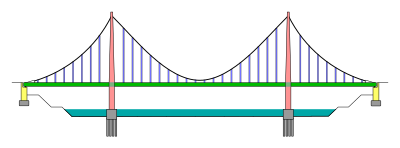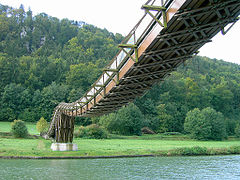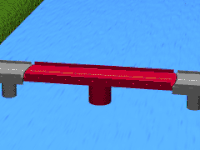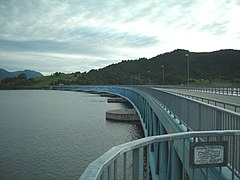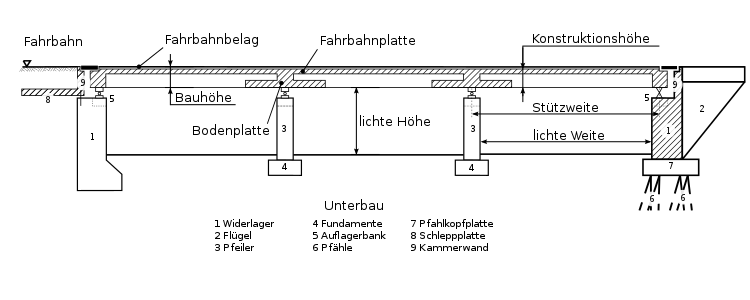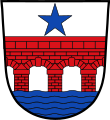bridge

from front to back: covered wooden bridge ( girder bridge with hollow beams), bricked stone bridge ( arched bridge ), prestressed concrete bridge (girder bridge)

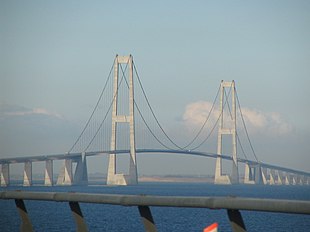
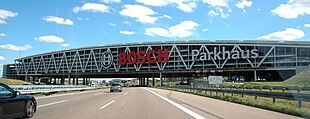
A bridge is a structure that leads traffic routes ( roads , sidewalks and cycle paths , railways , waterways, etc.) or supply facilities (such as pipelines , cable lines, conveyor belts, etc.) over natural obstacles (streams, rivers, gorges, etc.) or other traffic routes.
Green bridges are wild animals , highways to cross safely. Buildings
erected across traffic routes or areas to be kept free are also referred to as bridges .
Structural forms are beam bridges, arch bridges and suspension bridges .
history
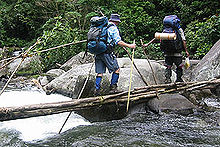

One of the oldest archaeologically secured bridges is the prehistoric wooden bridge Rapperswil – Hurden , which was built around 1525 BC. BC connected the Neolithic settlements Rapperswil-Jona-Technikum and Freienbach-Hurden-Rosshorn and was used for several centuries. The main building materials were wood , but stone was also used to strengthen the wooden pillars. Other prehistoric bridges were known from England and northern Germany.
In the 6th century BC The Babylonians under Nebuchadnezzar II built bridges out of cypress and cedar wood . The Romans already mastered the construction of arched bridges made of natural stone or concrete, as the Alcántara bridge still impressively demonstrates.
For at least 1000 years, bridges in Asia and South America have been constructed as suspension bridges over narrow gorges made of plant fibers, the last still functioning of this type is the Q'iswachaka suspension bridge , it is made entirely of grass.
Until the 19th century dominated wood and stone as a building material, but already with the industrialization originated in 1779 with the new building material cast iron the first iron bridge in the world, the Iron Bridge , an arch bridge of 30 m span over the River Severn at Coalbrookdale ( England ) which Abraham Darby III built. The further development of the new building material into tough and tensile wrought iron made it possible to build long chain suspension bridges . One of the first significant ones was the Menai Bridge in Wales with a main span of 177 m and a total length of 521 m, built by Thomas Telford between 1818 and 1826. The industrial production of rolled girders encouraged the construction of truss girder bridges , such as the Britannia Bridge in Wales by Robert Stephenson from 1850, with spans of 146 m in length.
The second modern building material, concrete , was used as stamped concrete in arched bridges from the mid-1860s , the first reinforced concrete beam bridge was built in 1875 by Joseph Monier on a country estate near Chazelet over a stream. Reinforced concrete bridges with large spans were designed as arch bridges at the beginning of the 20th century, as was the case with the Salginatobel Bridge in 1930 with a 90 m span.
With the development of prestressed concrete after the Second World War, the slim, prestressed girder bridge made of concrete finally became possible. For example, the Bendorfer Bridge from 1965 crosses the Rhine with a span of 208 m, the prestressed concrete girder bridge with the largest span in Germany (status: 2003). In parallel to the prestressed concrete bridges, the new construction form of the long - span cable - stayed bridge was developed in steel construction . The first large bridge of this type in Germany was the Theodor-Heuss-Brücke (Düsseldorf), opened in 1957, with a span of 260 m and a total length of 914 m.
definition
Germany
“All overpasses of a traffic route over another traffic route, over a body of water or over lower lying terrain are considered bridges if their clear width between the abutments is 2.00 meters or more. [...] "
Austria
The bridge is defined in the Guidelines and Regulations for Roads (RVS), Chapter 4 Artificial structures, whereby the same applies as in Germany.
Components
Individual components of a bridge are listed using a road bridge as an example. Other types of bridges do not have some parts, but also others (compare fixed and movable bridges). Not every road bridge has all the components. Rather, the components for each bridge are selected by the planner according to the requirements.
superstructure
The superstructure consists of the deck, the main girders and any cantilever arms and cross girders. The superstructure transfers the loads to the substructures. The ratio of the span to the height of the superstructure is called the slenderness ratio. Depending on the cross-sectional shape, a slenderness of 10 to 35 is possible.
Substructures
Abutments and pillars are referred to as the substructure of a bridge. The substructures take the loads of the superstructure and transfer them to the foundation.
Abutment
Abutments are usually located at the ends of a bridge and form the transition from the earth dam to the bridge superstructure. They transfer the superstructure loads to the foundation and absorb the earth pressure on the back of the abutment.
Resource support
The central supports reduce the span of the superstructure between the abutments and thus enable a lower construction height. Depending on the span, they direct parts of the superstructure loads into the subsoil. The central supports are usually designed as individual pillars or pillar washers . In the case of cable-stayed bridges or suspension bridges, the central support is required by hanging up the bridge loads. In this case it is called a pylon .
founding
The foundation of the abutments and middle supports and the transfer of the bridge loads are carried out with shallow foundations (strip foundations, foundation slabs) or deep foundations (bored piles, driven piles or wells).
fighter
Fighter is a special name for an abutment in an arch bridge.
camp
The bearings of a bridge are the contact points between the superstructure and substructure. They must be designed in such a way that they enable the necessary rotating and tilting movements as well as displacements and enable the transfer of the support forces with little constraint.
Steel bearings
Steel bearings are available as fixed linear tipping bearings or as movable linear bearings (roller bearings). Since numerous damages have occurred in the past, these are no longer used for new bridges in Germany. Roller bearings consist of steel cylinders that are held on the side and bearing plates, also made of steel. They can compensate for large movements of the bridge.
Elastomer bearings
Elastomer bearings are deformation bearings, ie they transfer the forces through the deformation of the elastomer. They consist of a flexible, age-resistant plastic , in which steel plates are incorporated in reinforced bearings, which increase the compressive strength and reduce the compressibility. The deformation bearings are movable on all sides and allow the absorption of horizontal and vertical loads with simultaneous rotation about three axes and with simultaneous displacement in two directions. The displaceability in the horizontal direction can be prevented by the arrangement of retaining structures made of steel. The elastomer bearing cannot absorb as large movements as a roller bearing, but it requires less maintenance because the steel sheets do not come into contact with air and moisture and are therefore protected against corrosion and there are no moving parts. For larger deformations, the deformation sliding bearing is used, in which the elastomer bearing is provided with an additional sliding layer.
Concrete bearings
With appropriate dimensioning and geometry as a concrete hinge , reinforced concrete can also absorb rotations and thus act as an immovable bearing.
Lane crossings
The superstructure of a bridge deforms in the longitudinal direction as a result of temperature changes and longitudinal forces from the brakes of vehicle traffic and, in the case of prestressed concrete bridges, additionally due to the prestressing and the creep and shrinkage of the concrete. These deformations do not occur on the abutment and must therefore be compensated for by a transition structure. In addition, the lane crossings should allow safe crossing even at high speeds.
On the sidewalks in the area of the caps or cornices, this joint gap must be covered with a cover plate or closed flush with suitable joint profiles. The cover plate is made of stainless steel in accordance with DIN EN 10088 . For several years now, lane crossings made of hot-dip galvanized steel have also been used.
Caps (DE) - Edge beams / cornices (AT) - Console heads (CH)
The edge formation of bridges made of reinforced or prestressed concrete that is not used is called a bridge cap; it can also be designed as a curb to delimit the lane or to protect pedestrians or cyclists. Bridge caps have a wide variety of functions. In addition to protecting the load-bearing bridge structure, they are used to anchor passive protective devices and as a bicycle and / or pedestrian path.
The reinforced concrete caps are only subsequently concreted on together with the cornice after the decking has been stripped and the seal has been made. In this way, dimensional inaccuracies in the cantilever arm of the superstructure can be concealed. The caps are frictionally connected to the superstructure by connecting reinforcement or plate anchors. Bridge anchors with ring nuts are often used in Austria. Railings and, if necessary, guardrails and noise barriers are attached to the caps . The caps are usually made of air-entrained concrete that is resistant to frost and de-icing salt and are increasingly being reinforced with hot-dip galvanized reinforcing steel in order to avoid chloride- induced corrosion of the reinforcement and to improve durability. They are made hydrophobic or coated if this is necessary, for example, because they are used as a walkway or bike path. In inner-city areas, the caps are mostly at the same time a pavement or bicycle path and secure them with a 15 cm high curb in front of a stray motor vehicle. Normally, the caps are only 7 cm higher than the carriageway and secure traffic by means of distance barriers.
Road surface and waterproofing
Road surface
Nowadays the road surface in Germany has a three-part structure consisting of a waterproofing layer, a protective layer and a top layer. The approx. 2 cm thick sealing layer consists of bitumen welding sheets (with or without metal lamination) and protects the bridge superstructure from the ingress of surface water, frost and de-icing salt. A cover tape placed on the overlap joints prevents cover and adhesive from penetrating into the protective layer. The approx. 4 cm thick protective layer consists of mastic asphalt or rolled asphalt and serves to protect the waterproofing against mechanical stress from traffic and the weather. An approximately 4 cm thick surface layer of asphalt concrete is applied to the protective layer in order to directly transfer the road loads. Road surfaces made of wood are also used on subordinate private roads, such as forest roads or house driveways, while natural stone was used on old bridges (such as Roman bridges).
drainage
The drainage should drain the surface water quickly and completely, and not only for reasons of traffic safety, but so that the surface can dry out as quickly as possible. As a rule, the water is drained into rain overflow basins via a drainage system.
equipment
railing
Bridge railings serve as fall protection for pedestrians or cyclists. The railings are made of steel or aluminum and have a minimum height of 1.0 m for a fall height of less than 12 m, for a greater fall height the minimum height is 1.1 m. In addition to cycle paths, a handrail height of at least 1.2 m is required in Germany ( 1.3 m according to the “ Recommendations for cycle traffic facilities ”). In the case of road bridges longer than 20 m, the two-part handrail also contains a wire rope.
Distance guard rails (de) - Guard rails / guard rails (at)
Guardrails or distance barriers serve as fall protection for motor vehicles or to secure the oncoming lane against breaking out of vehicles. These are made of steel , in Austria some of them are made of aluminum . However, the use of aluminum is not without its problems, because it becomes brittle over time and it is not uncommon for accidents to lead to serious and extremely serious physical injuries. That is why new aluminum crash barriers are no longer being erected in Austria and existing crash barriers are being replaced. As an alternative to the distance barriers, concrete barriers are also provided to delimit the lane on motorway bridges in Germany .
Classification
Bridges can be classified according to different criteria :
property
- public property (belonging to a public corporation (state, state, city, municipality ...))
- private property ( belonging to one (or more) natural or legal persons , including public companies )
- Mixed forms, both private-public , as well as several legal persons, as well as several public corporations (one solution for this used to be the bridge office, which existed in various cities until the 19th century )
use
A distinction according to the use often depends on the property: road bridges and pedestrian bridges in public street space are mostly publicly usable. Private bridges in the public road space are usually subject to tolls . Private bridges on private land can only be used privately.
location
The topographical location is a criterion for the allocation of bridges: For example, a distinction can be made between valley bridges , slope bridges , river bridges or canal bridges and high bridges .
function
Another classification of bridges follows their function. According to this - in the traffic sector - a distinction is made between road bridges , pedestrian bridges , railway bridges, light rail bridges, etc.: A railway bridge thus carries railways, a road bridge roadways. In hydraulic engineering it is a canal bridge / water bridge (as a trough bridge ). From an environmental point of view, the Wild Bridge (as the Green Bridge ) is known. Often, however, a bridge has several purposes.
Other types of bridges with functional names include the conveyor belt bridge (in mining), the line bridge (for example in the chemical plant) but also the pioneer bridge . There are also temporary bridges. On the other hand, auxiliary bridges are those made of prefabricated, mostly steel modular elements, which are used for repair work on existing bridges to bypass the construction site. An auxiliary bridge can remain in use for a longer period of time. Bridges can also have no function for a longer period of time: These are then popularly known as " soda bridges ".
Shape and construction

According to technical criteria, a classification according to shape and construction, material and weight is possible.
Girder bridge
The external characteristic of the girder bridge is usually the visible separation of the superstructure ( bridge girder ) from the substructure (supports, abutments) by bearings . The bearings transfer the loads from the superstructure to the substructure and give the bridge girder the necessary positional security and freedom of movement. The cross-sectional shape in the longitudinal direction corresponds externally to a beam , mostly the beam height is constant. Superstructures with variable superstructure heights are possible. As a rule, the lower chord has a curvature in accordance with the moment load; it is haunched . The beam makes optimal use of the strength of the material and is used as a static system in conventional bridges with small to medium spans (approx. 80 m). Economic spans for girder bridges are up to 100 m, approx. 100–200 m for extradosed bridges and from 200 m for cable-stayed bridges . The girder bridge is often found mainly because of the comparatively simple production. Many bridges over motorways are designed in this way. Beam bridges can be designed with various cross-sectional geometries in the transverse direction.
Plate bridge
In terms of the static system, the solid panel is a wide beam. The plate is often used for overpasses, especially in crooked structures, with a limited overall height and a maximum span of 30 m. The full plate is often provided with cantilever arms on both sides and is then similar to the single- web T -beam. A particular problem with the solid board is the accommodation of the drainage.
T-beam
The T-beam combines the properties of a plate with those of the beam. In order to achieve greater spans or to save material, one or more girders are arranged in the longitudinal direction of the bridge under a comparatively thin plate.
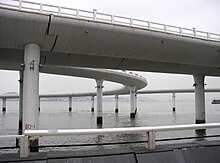

Box girder
Adding a lower plate to the plate beam results in a closed cross-section, which is called a hollow box . In particular, in the case of girder bridges with medium and larger spans or with curved lines, hollow box cross-sections, also called box cross-sections, are used. These are characterized by a high level of flexural and torsional rigidity , which enables great slenderness and efficient construction methods, such as the incremental launching method . Carriageway slabs that protrude far are often supported on the box girder via inclined compression struts.
Frame bridge (integral bridge)
Frame bridges correspond to girder bridges, but with the difference that the superstructure is rigidly connected to the substructures (abutment walls or columns). As a result, the bending moments in the field of the bridge girder are reduced, and thus its structural height can be reduced, or a greater span can be achieved for a given structural height. This is often used on freeway overpasses in order to be able to do without central pillars. The elimination of bearings reduces maintenance costs and simplifies maintenance of the bridge. However, replacing the superstructure, for example after collision damage, is more complex.
Bridges whose superstructures have no joints or bearings, i.e. are clamped into the abutment walls and any supports, are referred to as integral bridges . A variant of this type of construction are semi-integral bridges in which the superstructure is not completely monolithically connected to the substructure or in which the superstructure has joints.
Truss bridge
Trusses are dissolved structural structures . They have the advantage of lower material consumption than comparable full-walled structures such as beams (→ lower dead weight). The bars of the framework are mainly subjected to tension and compression . A disadvantage is usually the greater height of the construction. Truss bridges are mainly made of steel (sometimes also as timber construction ). Due to the high traffic loads , they are often built for railroad overpasses , but are also used for road bridges with larger spans, especially in the USA. Half-timbering is also hidden under the cladding of covered wooden bridges .
- Construction forms of truss bridges
Lattice girder bridge
Lattice girder bridges are bridges with girders made of a large number of diagonally crossing bars, which are connected to one another at the crossing points. The technology was developed in the USA in 1820 for the construction of covered wooden bridges. After the introduction of wrought iron made using the puddle method in Great Britain , the principle was transferred to wrought-iron lattice girder bridges, which could be manufactured more cheaply than the first box girder bridges with fully enclosed surfaces. This construction method was used from 1847, mainly in the 1860s and occasionally until around 1900.
Pendulum pier bridge
With pendulum pier bridges, the piers are articulated to the superstructure and the foundation . As a result, the pillars are only subjected to compressive forces , while the longitudinal forces, for example from braking or starting vehicles, are completely transferred from the superstructure into the abutment .
| Pendulum pier bridge | ||
|---|---|---|
 |
||
|
||
Arch bridge
The bow is for solid building materials, such as stone or concrete, with its high compressive strength the most appropriate structure type, since the arc almost exclusively exposed to pressure loads here at optimal geometry. That is why this type of construction can be found on many old bridges. However, the subsoil must be sufficiently firm because, in addition to the vertical forces, it must also absorb horizontal forces. The abutments at the end of the arch are called fighters .
Arch bridges are made of steel or reinforced concrete with elevated, overhead roadways for overcoming deep valleys or terrain cuts. With a steel arch spans of up to 500 meters are possible, with a reinforced concrete arch 300 meters are possible. Steel arch bridges with attached, underlying carriageway occur due to the low construction height of the carriageway panel, especially in flat areas when crossing bodies of water. Arch bridges with a central carriageway, such as the Karmsundbrua , are another possible way of overcoming obstacles. A modern design are the CFST bridges (concrete filled steel tube bridges) , which have been built in China since 1990 , in which the load-bearing arch is first made from empty steel tubes, which are then filled with concrete.
An arch bridge consists of one or more arches and the bridge panel or deck. The steel arch bridge also has hangers or posts to which the bridge panel is attached.
Construction forms of arch bridges:
| Overhead roadway | Padded arch (old stone bridge) | ||||
|---|---|---|---|---|---|
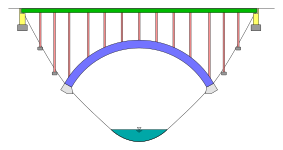 |

|
||||
|
|
||||
| Roadway below | Bow with drawstring (fake bow, usually) | ||||

|

|
||||
|
|
Suspension bridge
The suspension bridge is a further development of the rope bridge. Simple suspension bridges with a still sagging roadway can be found in Stone Age cultures. The suspension bridge is mainly built to cross broader navigable waters with spans above 800 m. Due to the tendency towards larger deformations, it is rarely used as a railway bridge (examples are the Tsing Ma Bridge and the Ponte 25 de Abril ). It is statically similar to the arch bridge with the roadway below. At the suspension bridge, a suspension cable is suspended between pylons . Hangers, vertical ropes that carry the roadway, are attached to this support rope. However, with large spans they are very susceptible to wind vibrations, as the collapse of the Tacoma Narrows Bridge in the USA on November 7, 1940 showed.
A famous example of a suspension bridge is the Golden Gate Bridge in San Francisco . The Akashi Kaikyō Bridge in Japan has had the largest span since 1998 with 1991 meters.
Cable-stayed bridge
The cable-stayed bridge or cable-stayed bridge has proven to be technically particularly suitable and economical for bridging wider bodies of water or areas with spans between 200 m and 1000 m. The bridge is usually built using a cantilever . The state of construction with the widely cantilevered bridge is decisive for the technically possible span widths due to the lateral wind load. Due to its high rigidity, it can also be used for rail transport. A cable-stayed bridge consists of the pylons, the roadway and the ropes. All vertical forces of the bridge are introduced into the pylon via the cables, which then apply them vertically as pure compressive forces into the ground. The cable-stayed bridge corresponds to a cantilever bridge, the pavement board forms the pressure-loaded lower chord, the cables are cantilever tension belts which transfer the vertical loads to the pylons and are anchored back in the pavement board.
A well-known example of this type of bridge is the Hamburg Köhlbrand Bridge . The Rio-Andirrio Bridge , which leads over the Gulf of Corinth (Greece), is another well-known representative of this bridge shape and one of the longest of its kind. The Viaduc de Millau has been the longest cable-stayed bridge in the world since 2004 at 2,460 m.
| single-hip cable-stayed bridge, harp shape | double-hip cable-stayed bridge, tufted shape | |||||
|---|---|---|---|---|---|---|
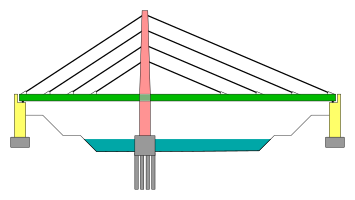 |
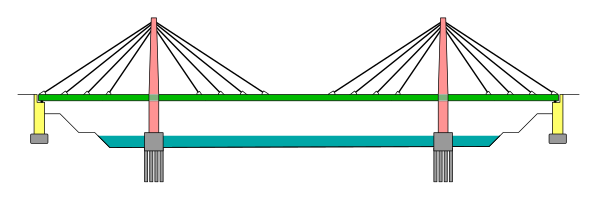
|
|||||
|
||||||
Extradosed bridge
An extradosed bridge is a new type of bridge construction (a bridge with external prestressing) with stay cables, which is a mixture of a cable stayed bridge and a prestressed girder bridge. Economic spans for girder bridges are up to approx. 100 m, 100–200 m for an extradosed bridge , and from approx. 200 m for a cable-stayed bridge .
Smuuli Bridge in Estonia
Sunnibergbrücke in the Klosters bypass , Switzerland
Tension band bridge
The load-bearing element of a tension strap bridge is one or more straps that are tensioned by the load and connected to the end bearings in a tensile manner. The concave sagging of the tension band in the fields is characteristic. The smaller the sag, the greater the tensile forces in the tension band. Because of the sag, this design is mainly built as a pedestrian bridge. The tension band can be guided over intermediate pillars. A well-known representative of this type of bridge is the wooden bridge near Essing over the Main-Danube Canal , which, in addition to the unusual use of glued laminated timber as a tensioning strap, was also the longest wooden bridge in Europe up to 2006 at 193 m. This status was transferred to the 225 m long Dragon Tail Bridge on the grounds of the Neue Landschaft Ronneburg . In the case of road bridges, the roadway is usually elevated above the tensioning strap, so that despite the slack of the tensioning strap, a roadway is created that corresponds to the alignment of the road.
Tension band bridge near Essing between Riedenburg and Kelheim
Passerelle Lignon, a pedestrian walkway in the canton of Geneva , Switzerland
Movable bridge
Movable bridges are built when the local conditions mean that a fixed bridge is not economically or structurally possible. This can be the case if, for example, a ramp would be too expensive in the flat country and, without a ramp, there would be too little clearance for the traffic line below. This type of bridge has the disadvantage that the traffic crossing cannot take place independently of one another, but one of the traffic routes is always blocked or at least restricted.
These bridges are described in more detail by the type of construction. There is the drawbridge or drawbridge , where the carriageway is folded up, the bascule bridge , the mechanism of which has no pull ropes (the most famous example is Tower Bridge in London), a drawbridge like near Gouda in the Netherlands and as a special variant a three- span bascule bridge , like the Hörnbrücke in Kiel, a folding bridge . Other movable bridge types that cross shipping lanes and enable larger passage widths are the swing bridge , which can be rotated completely around its vertical axis (the Malchow swing bridge ), the lift bridge , which is raised completely (the Kattwyk bridge over Hamburg's southern Elbe) or in Haarlem in the Netherlands , as well as the tilting bridge , the sinking bridge and the rolling bridge (rolling bridge).
Turning out the Nordschleusenbrücke in Bremerhaven to clear the waterway:
Floating bridge (pontoon bridge, ship bridge)
Instead of pillars, floating bridges have floating bodies on a body of water that connect short superstructures. Pontoons , ships, rubber boats, hollow plates or amphibious vehicles are used as floating bodies . The usability of swimming bridges is particularly influenced by the water level and the water flow. Depending on the water level, when driving on the bridge between the bank and the first floating body, a considerable upward or downward gradient has to be overcome, which makes it difficult or impossible to use, especially with railway bridges. Often the bridge is guyed on the bank because otherwise it only has a low transverse rigidity.
Swimming bridges are mostly used as temporary bridges to replace destroyed infrastructure until they are restored. A typical application is in the military sector, where on the one hand the aim is to temporarily restore destroyed infrastructure, but on the other hand also to gain operational advantages through flexibility. In the past, floating bridges were used as an inexpensive alternative to fixed bridges.
In Norway floating bridges are still being built as permanent structures. One example is the 845 m long Bergsöysund Bridge near Kristiansund , which has an arched floor plan without anchoring. The 1246 m long pontoon bridge section of the 1614 m long Nordhordlandsbrua near Bergen is of the same type of construction . In contrast, the 2019 m long Lacey V. Murrow Memorial Bridge over Lake Washington near Seattle is straight in plan and held in the transverse direction with anchors .
material
Wooden bridge
Wood is the oldest bridge building material in the form of a tree trunk over a gorge or a body of water . It is used for yoke bridges and truss bridges. In the 18th century, wooden bridge construction reached its first high point with the Schaffhausen Rhine Bridge by Hans Ulrich Grubenmann . This was 120 m long and had only one intermediate pillar. The further development took place in the first half of the 19th century in North America with the construction of the railway lines through the continent, among other things with the wooden trestle bridges , consisting of simple girder bridges with a fine-meshed arrangement of round timbers.
Wood is used in particular for pedestrian bridges, footbridges or other subordinate bridges such as goods road bridges or house driveways. The low weight of the wood is particularly advantageous. Wood is rarely used for larger bridges, such as near Mäntyharju in Finland . The longest wooden bridge in the world approved for road traffic was opened there in 1999 at 168 m (maximum span 42 m). The longest covered wooden bridge in Europe is the Bad Säckingen wooden bridge in southern Germany. The Chapel Bridge in Lucerne is one of the most famous . The longest covered wooden bridge in the world is the Hartland Bridge in New Brunswick , Canada , at 390 meters .
Rope bridge

The rope bridge is one of the oldest types of bridges, although there are several variants:
- The 1-rope bridge is the simplest variant and consists of an inclined tensioned rope that is used hanging on a pulley.
- The 2-rope bridge consists of a supporting rope (below) and a holding rope (above). This is a very shaky affair because the support and tether can move horizontally to each other.
- The 3-rope bridge is an improvement on the 2-rope bridge with an additional tether and connections between the tethers and the carrying rope. This increases stability and makes using the bridge safer.
- Compared to the 3-rope bridge, the 4-rope bridge is supplemented by a further suspension rope. A covering (mostly made of wood) is attached between the two suspension cables. This increases the convenience of use.
Pure rope bridges can still be found in Africa , Asia , South America and Micronesia . The rope is often made of natural fibers, sometimes steel.
Massive bridge

Stone bridge
Stone bridges are bridges in which not only the bridge piers, as is the case with iron or wooden bridges, but also the superstructure are made of stone. Stone was used as a bridge building material early on , initially with unprocessed ( clapper bridge ) and later with processed stones.

First the stone bridges with cantilever arches and then as technology advanced as real arched bridges. If the distance to be bridged is short, stone bridges can be built with a single arch stretched from bank to bank, and for larger distances with several arches vaulted between stone pillars on which the bridge board lies. Differences arise here from the shape of the arc , which can be a semicircle, a flat arc (stitch arc / segment arc), a pressed or a raised arc. The semicircular arch bridges of the Romans had spans of up to about 28 meters ( Bridge of Alcántara ). A maximum clearance of around 45 meters is possible with this geometric shape with stone bridges, which was achieved with the Pont du Diable bridge in France. With the segmental arch used from the Middle Ages, which is statically more favorable but more difficult to control due to the higher sideshift, spans of up to 72 meters could be achieved with stone bridges. The Trezzo Bridge , with a segmental arch of 72 meters clear width, was the largest stone arch bridge in the world for 39 years until it was destroyed. Stone is only of secondary importance in bridge construction, mostly in the form of cladding.

Concrete bridge
Concrete is an artificial stone made from a mixture of cement , aggregates ( sand and gravel ) and water that solidifies as a result of a chemical reaction. Concrete can also contain concrete additives and admixtures. This building material is ideal for building bridges because it can be poured liquid into any shape and after hardening results in an artificial stone that can withstand pressure. Concrete (like stone) is only able to absorb high compressive forces and low tensile forces , which is why it is mainly used in arched bridges.
Reinforced concrete bridge, prestressed concrete bridge
Reinforced concrete combines the advantages of concrete and steel . The concrete surrounds the steel and protects it from corrosion . The steel brings its tensile strength into this connection , which is only possible because both materials have a very similar coefficient of thermal expansion .
There are several types of reinforced concrete:
- Reinforced concrete: The reinforcement is built into a formwork and then poured with concrete. This is called slack-reinforced.
- Prestressed concrete : The use of prestressed concrete bridges is the norm for spans of more than 10 m to 25 m. A part of the reinforcement, the prestressing steel , is preloaded (tensioned). This results in a compressive stress in the concrete, which prevents the concrete from cracking and thus preventing greater deflection. This enables lower construction heights of the bridge girders. With regard to the position of the prestressing steel in the bridge cross-section, it differs between internal prestressing and external prestressing . With internal pre-tensioning, the tensioning cables are arranged in the concrete cross-section and completely encased by the concrete. With external prestressing, the tendons are outside the concrete cross-section and can be replaced. The tension forces are only introduced into the concrete cross-section at deflection saddles or consoles. The external prestressing is mostly used in combination with the internal one for hollow box cross-sections.
Metal bridge
Cast iron bridge, wrought iron bridge
Cast iron is an iron - alloy with lower melting point than steel , and therefore easier to manufacture. Due to its low elasticity, the brittle cast iron is no longer important in structural buildings and was first replaced by wrought iron , then by steel. Many bridges used to be made of cast iron, for example The Iron Bridge over the Severn . Most of the cast iron bridges could not cope with the increasing load and were therefore replaced by steel bridges. Only the pendulum supports could cast iron hold up until the beginning of the First World War. One example of this is the Hartung column , which was used in large numbers when the railway system in the Berlin area was expanded from 1880 to 1910.
Steel bridge
Steel has a very high resistance to compressive and tensile forces. Steel is mainly used in bridge construction in the form of ropes, profiles or sheet metal. Cast steel parts are being used to an increasing extent. One disadvantage can be rusting ( corrosion ). In contrast to hot-dip galvanized bridges, which have a corrosion protection duration of 100 years, the coating of coated bridges usually has to be renewed after about 30 years. Steel is mainly used in the superstructure of tied arch bridges, deck bridges, truss bridges and suspension bridges.
Composite steel bridge
Structural structures in composite structures have spatially separate cross-sections that consist of two or more building materials. In contrast to, for example, reinforced concrete , the bond with each other is created using special fasteners. For example, in the case of a composite steel bridge, the deck, which is made of reinforced concrete, lies on the steel bridge girder. The bond between the two building materials is ensured by head bolt dowels . This results in a non-positive connection and both cross-sections work together as one cross-section. When coupling pre-stressed concrete and steel composite construction parts, they are called hybrid bridges .
CFST bridge
A special type of composite steel bridge are the CFST bridges (concrete filled steel tube bridges) , which have been built in China since 1990 , in which the load-bearing arch is initially made from empty steel tubes, which are then filled with concrete.
Aluminum bridge
The first use of aluminum in bridge construction took place in 1933 with the renewal of the road construction of the Smithfield Street Bridge in Pittsburgh. In 1946, the single-lane railroad bridge Grasse River Bridge, which was made of newly developed aluminum alloys, was built near Massena (New York) with aluminum main girders. In later years, extrusion technology was further developed. It enabled the production of profiles specially tailored to the requirements of bridge construction. In the period between 1980 and 1990, the aluminum bridge , which is characterized by its low weight, corrosion resistance and low maintenance costs, became widespread in the Scandinavian countries. Germany's longest aluminum bridge is located in Lahr / Black Forest . It is 48 meters long and weighs 31 tons.
Plastic bridge
Bridges have also been built from fiber-plastic composites since the 1990s . The technology is mostly used on smaller bridges for pedestrians and cyclists. One of the oldest designs is the footbridge built in 1990 on a golf course in Aberfeldy , Scotland . In Boothbay, Maine is currently the longest bridge made of plastic, the 160 meter long Knickerbocker Bridge. According to studies from the Netherlands, plastic bridges require less embodied energy than bridges made from conventional materials, and their construction releases less CO 2 .
One of the oldest plastic bridges on the Aberfeldy golf course
GRP bridge over the B106 near Schwerin
geometry
In plan and elevation

In modern bridge construction, the principle that the bridge is part of the road has evolved so that it follows the route of the road. This results in a large number of geometric variations. For example, the intersection angle between a country road and a freeway does not have to be right-angled. A bridge is a crooked bridge , as opposed to a straight bridge . If a bridge is in the radius, it is referred to as a bridge that is curved in plan, if it is in a trough or a dome, it is called a curved bridge in plan . But there are also bridges that are curved both in plan and elevation, bridges that are located in twisted areas of the roadway or even bridges that are located in the area of a change in the curvature of the roadway (clothoid). For those involved in the construction work, irregular geometries and widening in the area of a bridge are major challenges, since complicated building geometries are often incompatible with current construction methods and require the development of special or the modification of current construction methods.
In cross section
In particular, when bridges are used differently, two carriageway levels are often arranged to separate traffic. A well-known example of such double-decker bridges is the Øresund Bridge , which accommodates road traffic above and rail traffic below. The separation of the directional lanes of multi-lane road bridges, as with the Bay Bridge , can be done with two-story bridge superstructures. Multi-storey bridges have the advantage that the statically necessary construction height is also used as a traffic area. This reduces the dead weight of the bridge, as the bridge width is smaller and the necessary cross beams are lighter.
Viaduct and culvert
viaduct
With Viaduct and long road or rail bridges are more or less high referred to steigungsarm a valley or a sink with pillars and usually arches span. Similar constructions, the aqueducts , were used by the Romans to supply drinking water. Viaducts were often built later in railway construction.
passage
A small structure with a clear width of less than two meters in the earth's body of a traffic route is considered a passage . It is built when a footpath or a small stream has to be led through a road or rail embankment. Passages are mostly designed as reinforced concrete frame structures or with corrugated steel pipes .
Special equipments
Some bridges have extraordinary installations. The pylon of the bridge of the Slovak National Uprising in Bratislava carries a tower restaurant. Other bridge piers of suspension bridges have transmitting antennas. On electrified railway lines, components made of electrically conductive material must be earthed for safety reasons on all bridge structures due to the live overhead lines .
As part of a pilot project , Germany's first bridge with a heated lane was inaugurated on October 20, 2011 in Berkenthin in Schleswig-Holstein over the Elbe-Lübeck Canal . Using geothermal energy , water with a temperature of 11 ° C is used from a depth of 80 meters. The aim of the project is to reduce the number of accidents caused by slipperiness. Special conditions in Berkenthin ensure there is frequent alternation between frost and dew during twilight. The construction of the new bridge cost around 9.7 million euros, of which around 1 million euros went to the geothermal system.
Overhead lines on bridges
Catenary masts and masts for telephone lines on bridges are not uncommon. In the case of truss bridges with the carriageway below, cross members are often installed on the truss structure to accommodate the lines. However, there are bridges that carry overhead lines of the interconnected network, such as Storstrømsbroen .
Other terms
Important terms of a bridge include:
- Support width or span : the length between two support points in the longitudinal direction of the bridge
- Clearance: the distance between the delimiting components, such as pillars or abutments, of a bridge opening
- Clear height: the distance between the subsurface and the lower edge of the structure
- Construction height: Measure from the lower edge of the construction to the upper edge of the track / rail
- Construction height : Dimension from the lower edge of the construction to the upper edge
- Crossing angle : angle between the axes of the crossing objects (specified in grads )
Bridge maintenance
The bridge maintenance consists on the one hand of the construction supervision and inspection. These are regulated in Germany in DIN 1076 and include continuous monitoring every three to six months, a simple test or control every two to three years and a main test every six to ten years. On the other hand, the building maintenance consists of building maintenance with the maintenance and care of the building as well as the repair of the building. In Germany, maintenance costs are higher than new construction costs. According to a study by KIT, the service life of welded steel bridges can be significantly extended by post-treatment of the weld seam transitions . A study by the Federal Highway Research Institute (BASt) comes to the conclusion that maintenance-free, hot-dip galvanized steel and composite steel bridges are significantly more sustainable and cost-effective than coated bridges, which usually have to be completely repaired after 33 years.
There are several methods of monitoring the health of bridges. For example, accelerometers can be integrated into the structure for long-term monitoring when building a bridge . Another option is contactless status control based on the Doppler effect . The laser beam from a laser Doppler vibrometer is directed onto the surface of the measurement object. The frequency of the light backscattered from the surface is changed by the movement of the bridge ( Doppler shift ). By means of an interferometric evaluation, the oscillation speed or displacement at the measuring point can thus be precisely determined from the light scattered back from the object surface.
In bridge construction, especially on motorway bridges, cathodic corrosion protection (KKS) is carried out using an impressed current anode. For this purpose, an anode grid made of coated titanium is applied to the surface to be protected and about 2 cm to 3 cm is injected with shotcrete . The shotcrete serves as an electrolyte . The current is fed into the reinforcement via a rectifier, thus providing cathodic protection. The measure is continuously checked with an automatic monitoring system.
According to information from Deutsche Bahn, 9,000 of the 25,000 railway bridges are more than 100 years old. 1400 bridges urgently need to be renovated. (Stand 2013)
Manufacturing
Bridges can be built on the spot, made at another location and, for example, transported by ship or made at the construction site and pushed into their final position.
Hydraulic presses are used when pushing in longitudinal or transverse direction, as in June 2013 in Viersen, 2003 in Krefeld, Tutzing ( railway line Munich-Garmisch-Partenkirchen ) and June 2011 in Metzingen (4110 ton arched arch bridge with a clear width of 68 meters) .
Concrete bridges with a low height above the ground can be constructed inexpensively with a falsework . In the case of multi-span bridges, the superstructure is usually concreted in sections, for which purpose a falsework can be used or, in the case of high bridges, an advancing tower .
Feed scaffolds are scaffolds that move independently from one bridge bay to the next. This type of scaffolding is mainly used for bridges with changing curve radii, different gradients, changing spans and for railway bridges that consist of a chain of single-span girders.
Otherwise, longer prestressed concrete bridges, continuous girders with regular spacing between columns and box girder cross-sections are often manufactured using the widespread, economical incremental launching method ( incremental launching bridges ).

Cantilever bridges are found for large spans , especially for building over wide bodies of water. The following construction phase is added to the freely protruding end. In the case of steel bridges or composite bridges in particular, the steel superstructure can often be assembled using lifting equipment such as a truck-mounted crane or winches.
In addition, in prestressed concrete there is still the option of building a bridge with prefabricated parts . In Germany, this mainly happens in the case of motorway flyovers, where the bridge girders are pre-produced and the carriageway slab only has to be concreted on top. In contrast, outside Germany, bridge construction with precast cross-sectional segments is very widespread. The bridge is created by joining and bracing individual pre-produced cross-sectional elements. A reinforced concrete arch, for example, can be erected in a guyed cantilever or with a self-supporting wooden framework .
The mean age of bridges over motorways and federal highways in North Rhine-Westphalia is 32 years according to the state road construction company and 42 years for bridges over state roads. With a service life of 80 to 100 years, you have achieved half of the planned useful life. However, they were originally designed for a significantly lower traffic load than they have to carry today.
Bridge as a symbol

The bridge is a widespread symbol of overcoming trenches and connecting across dividing borders. The designation of the Roman Pope as “Pontifex Maximus” (Supreme Bridge Builder) and the choice of the bridge as a symbol of church or social institutions with a dialogue mandate ( Evangelical Academy Bad Boll ) are linked to this. The name of the expressionist artist group Die Brücke at the beginning of the 20th century was intended to symbolize the departure to new shores . On the back of every euro banknote there is also a bridge as a symbol of the connection between the peoples of Europe and Europe and the world.
At the same time, and because of the increasing construction and traffic safety, the focus is less on the motif of the bridge for the fear of treading dangerous paths. Bridges can collapse, sometimes seem wobbly or not very trustworthy, lead over dangerous abysses and represent breaking new ground. Crossing a bridge is associated with the risk of falling ; In earlier times it was therefore often the builder who had to cross the bridge first to prove the stability. In the Middle Ages, bridge legends also emerged when the bridge was not built with the right things or even with the devil. Bridges were also considered a preferred location for robberies by highwaymen .
The fact that homeless people occasionally use the public space under bridge driveways as a shelter and living quarters has led to the expression under bridge houses becoming a pictorial expression for homelessness in the urban environment.
In heraldry , the bridge is represented as a building, but the term is also used to denote the tournament collar . See also bridge (heraldry) .
- Bridges as heraldic symbol
Friedrichshain-Kreuzberg district of Berlin
Fürstenfeldbruck in Bavaria
Marktheidenfeld in Bavaria
Königsbrück in Saxony
Bruck an der Mur in Styria
Innsbruck in Tyrol
Bridges in Art
Visual arts
In the Christian saint worship the bridge indicated as attribute to the method of execution of a martyr out who was overthrown by a bridge. The most famous representative is St. Nepomuk , who is considered the patron saint of bridges. Another well-known example is St. Florian . Such martyrs, as well as other saints, were invoked in the past to protect themselves from the danger often associated with crossing a bridge. They were often set up as statues on bridges and subsequently referred to as bridge saints .
From this derives the literal designation of a person as a bridge saint who can withstand all rigors in an exposed place in the face of wind, weather or other dangers and stands motionless as an uninvolved observer, without pursuing a recognizable activity or taking a clear position on the events surrounding him .
music
In songs and music, the bridge motif is usually symbolic of overcoming difficulties or solving more or less serious problems. This applies both to the English song literature, where Simon & Garfunkel sing about a " Bridge over Troubled Water ", as well as to the German-language repertoire. More or less well-known examples are the titles Over seven bridges you must go by the group Karat , sung by Peter Maffay , or Over each Bach'l leads a Brückerl by Stefanie Hertel . Pure demand for new bridges to bridge the gap created by racism and xenophobia, while the Red Hot Chili Peppers are "under the bridge". When Joy Fleming says " a song can be a bridge " and in their Neckarbrücke Blues it's "iwwer the Brick". Walter Mossmann sang about a politically connecting bridge in his Bruckelied from 1975 : the bridge between Wyhl and Marckolsheim , which played an important role in the protests against the nuclear power plant planned by Wyhl .
Transitions between individual parts of a song or interpretations (for example purely instrumental parts between vocal parts) are called Bridge (translated as “Brücke”, but not in use as a German word), whereby changes in rhythm or harmonies are possible, see Bridge (music ) .
literature
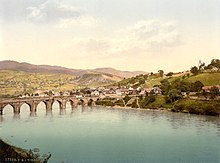
The bridge is a popular motif in literature. This ranges from ballads ( Theodor Fontane's Die Brück 'am Tay ) to novels ( Ivo Andrić : The Bridge over the Drina ; The Bridge of San Luis Rey by Thornton Wilder ) to well-known quotations.
"La majestueuse égalité des lois interdit aux riches comme aux pauvres de coucher sous les ponts, de mendier dans la rue et de voler du pain. »
"The sublime equality before the law forbids rich and poor to sleep under bridges, beg on the streets and steal bread."
Movie
Many films have bridges as a central motif. Because of their strategic importance, war films in particular deal with bridges. Examples are the works Die Brücke von Remagen or Die Brücke von Arnhem, set in World War II . In Germany, the name "Die Brücke" was used by a DEFA feature film , Bernhard Wicki's anti-war film and its remake . Other war films on the topic: The Bridges of Toko-Ri and The Bridge on the Kwai (based on a novel of the same name by Pierre Boulle ).
Choice of location
When selecting bridge locations, not only aesthetic and functional aspects but also ecological criteria are taken into account. Choosing the location of a bridge and a matching structure can be a difficult political process, as the example of the Dresden bridge dispute over the Waldschlößchenbrücke shows.
photos
Stone Bridge Regensburg
Chain Bridge Budapest
Main valley bridge Nantenbach , framework with composite steel plate
Diffené bridge, bascule bridge in the port of Mannheim
Bridge of Lies in Sibiu
The arch bridge Pont Saint-Martin
Griethausen Railway Bridge , the oldest still preserved railway bridge in the German section of the Rhine
Main valley bridge Gemünden , frame bridge
Göltzschtalbrücke , the world's largest brick bridge
Saale-Elster valley bridge , the longest bridge in Germany
Motorway bridge Siebenlehn , in the 1930s the highest motorway bridge in Europe
Europabrücke on the Brenner autobahn , the highest bridge in Europe in the 1960s
Suspension bridge made of roots in Sumatra
Blue miracle in Dresden
Stari most in Mostar, symbol of the city
Lists of superlatives
More lists
by rivers:
- List of bridges across the Danube
- List of Elbe bridges
- List of Moselle bridges
- List of Neckar bridges
- List of Rhine bridges
- Seine bridges in the Paris area
Throughout Germany
- List of medieval stone bridges in Germany
- List of the longest railway bridges in Germany
- List of the longest road bridges in Germany
For more lists, see category: List (bridges)
See also
literature
- Bavarian Society for Underwater Archeology eV (Hrsg.): Archeology of the bridges. Prehistory, antiquity, middle ages, modern times. Pustet, Regensburg 2011, ISBN 978-3-7917-2331-0 .
- David J. Brown: Bridges - Bold constructions over rivers, valleys, seas. Callwey-Verlag, Munich 1994, ISBN 3-7667-1114-8 .
- Eugen Brühwiler, Christian Menn: Reinforced concrete bridges. Springer-Verlag, Vienna 2003, ISBN 3-211-83583-0 .
- Dirk Bühler: Building bridges in the 20th century. Design and construction. DVA, Munich 2004, ISBN 3-421-03479-6 .
- Richard R. Dietrich: The fascination of bridges. Architecture - history - technology. Callwey, Munich 1998, ISBN 3-7667-1326-4 .
- Fritz Leonhardt: Bridges. Deutsche Verlags-Anstalt, 2002, ISBN 3-421-02590-8 .
- Alfred Pauser: Solid bridges - viewed holistically. History, construction, manufacture, design. Austrian Association for Concrete and Structural Engineering (for Austria). Verlag Bau + Technik (for Germany), 2002, ISBN 3-7640-0431-2 .
- Caspar Schärer, Christian Menn (Ed.): Christian Menn. Bridges. Scheidegger & Spiess, Zurich 2015, ISBN 978-3-85881-455-5 . (Text in German and English)
- Frank Tönsmann (Ed.): Bridges. Historic paths across the river. 13th Kassel Technology History Colloquium. Kassel University Press, Kassel 2006, ISBN 3-89958-117-2 (full text)
- Lucien F. Trueb: Concrete bridges - symbiosis of engineering and art. In: Naturwissenschaftliche Rundschau. 57, No. 10, 2004, ISSN 0028-1050 , pp. 537-543.
- Silvia Koci Montanari: The ancient bridges of Rome. Schnell & Steiner, Regensburg 2006, ISBN 3-7954-1814-3 .
- Christian Brensing (ed.): Two bridges - Bernhard Schäpertöns. JOVIS, Berlin 2010, ISBN 978-3-86859-083-8 .
- Karl-Eugen Kurrer : The History of the Theory of Structures. Searching for Equilibrium , Ernst & Sohn , Berlin 2018, pp. 58–101, pp. 190–195, pp. 200–210, pp. 221–222, pp. 241–247, pp. 252–256, p. 445 -448, pp. 471-476, pp. 483-491, pp. 603-615, and the like. Pp. 621-627, ISBN 978-3-433-03229-9 .
Web links
- Bernd Nebel - lots of information about bridges and bridge construction
- Structurae - International database for bridge and civil engineering with over 10,000 bridges
- brueckenweb - bridge database with 50,000 bridges and over 100,000 photos
- German bridges - website of the Federal Ministry of Transport on bridges in Germany, lots of statistical information
Individual evidence
- ↑ Website palafittes.org: Swiss sites in the UNESCO World Heritage Site , accessed on August 11, 2011.
- ↑ whc.unesco.org Prehistoric Pile dwellings around the Alps : Rapperswil-Jona / Hombrechtikon-Feldbach (CH-SG-01), Rapperswil-Jona-Technikum (CH-SG-02), Freienbach-Hurden-Rosshorn (CH-SZ -01), accessed February 10, 2013.
- ↑ Menai Strait Bridges. Warren Kovach, accessed August 6, 2009 .
- ↑ Sven Ewert: Bridges: The development of spans and systems . Ernst & Sohn-Verlag, Berlin 2003, ISBN 3-433-01612-7 , p. 214.
- ↑ Federal Ministry of Transport and Digital Infrastructure (Ed.): Guidelines for the design, structural training and equipment of civil engineering structures (RE-ING) . Part 2 Bridges - Section 2 Design Requirements, December 2017, p. 4 .
- ↑ DIN EN 10088-4: 2009-08: Stainless steels - Part 4: Technical delivery conditions for sheet metal and strip made of corrosion-resistant steels for the building industry; German version EN 10088-4: 2009.
- ↑ www.feuerverzinken.com .
- ^ A b Mike Schlaich, El Araby El Shenawy: Extradosed bridges - load-bearing behavior and adjustment of the rope forces for permanent loads. In: Structural Engineering. Vol. 90, July 2013, pp. 410-420. doi: 10.1002 / bate.201300001 .
- ↑ DB-Netze (Ed.): Guideline Design of Railway Bridges. 1st edition. 2008, p. 34 f.
- ↑ Pendulum pillar . In: Meyers Konversations-Lexikon . 6th edition.
- ↑ Gallery of the University of Fukuoka .
- ^ A timber bridge made of timber framing that amazes the world ( Memento from December 11, 2007 in the Internet Archive ), holzland.de.
- ^ Suspension Bridges - How the Inca Leapt Canyons. In: The New York Times . May 8, 2007.
- ↑ New bike bridge over the A5 near Lahr. In: Badische Zeitung. June 28, 2015. Accessed June 28, 2015.
- ↑ Composite bridges. (PDF; 283 kB) DSM , accessed on February 14, 2018 .
- ↑ Pedestrians are hit. In: Der Tagesspiegel . October 7, 2008.
- ↑ Safe through the winter: Berkenthin now has a heated bridge ( memento from August 2, 2012 in the web archive archive.today ) on: HL-live.de , October 20, 2011.
- ↑ Martin Bauer, F. Ritter, Georg Siegmund: High-precision laser vibrometers based on digital Doppler signal processing . Proc. SPIE 4827, Fifth International Conference on Vibration Measurements by Laser Techniques: Advances and Applications, 50 (May 22, 2002); doi: 10.1117 / 12.468166 .
- ↑ KIT - University of the State of Baden-Württemberg and national research center in the Helmholtz Association, extending the service life of existing and new welded steel structures, study .
- ↑ Sustainability calculation of hot-dip galvanized steel bridges . Report on the research project FE 089.0291 / 2013 in reports of the Federal Highway Research Institute, Bridge and Civil Engineering Booklet B112, Bergisch Gladbach .
- ^ Horst Falkner: Monitoring in the construction industry. ( Memento of the original from July 31, 2013 in the Internet Archive ) Info: The archive link was inserted automatically and has not yet been checked. Please check the original and archive link according to the instructions and then remove this notice. (PDF; 1.1 MB). In: The test engineer. Issue 4/2014, p. 41.
- ↑ Uwe Friebe, Gert Gommola: 90 years of bridge measuring systems on the railways in Germany. In: Measurement technology in construction. Ernst & Sohn Special 2013, p. 36.
- ^ Rapid Non-Contact Tension Force Measurements on Stay Cables , Transportation Association of Canada.
- ↑ Bahn increases the number of dispatchers . In: Stuttgarter Zeitung . September 2, 2013, p. 7 .
- ↑ Bridge module starts late. on: rp-online.de , June 6, 2013.
- ↑ Bridge installed. on: sueddeutsche.de , September 26, 2012.
- ↑ Bridge lands on the point. ( Memento from October 14, 2013 in the Internet Archive ) on: swp.de , June 27, 2011.
- ↑ Stefan Melneczuk: Brückentag: Start work in the Kohlfurth , rider lifespan of bridges. In: Westdeutsche Zeitung . (online), November 20, 2008.
- ^ Sibylla Vee: Money and its secrets in graphics and painting: Small picture stories . BoD - Books on Demand, 2019, ISBN 978-3-7504-0272-0 , pp. 92 ( google.cz [accessed February 29, 2020]).
- ↑ Ernst-Dietrich Haberland, Hans-Otto Schembs, Hans-Joachim Spies: Madern Gerthener "the city of Franckenfurd Werkmeister": master builder and sculptor of the late Gothic . J. Knecht, 1992, ISBN 978-3-7820-0654-5 ( google.cz [accessed February 29, 2020]).



